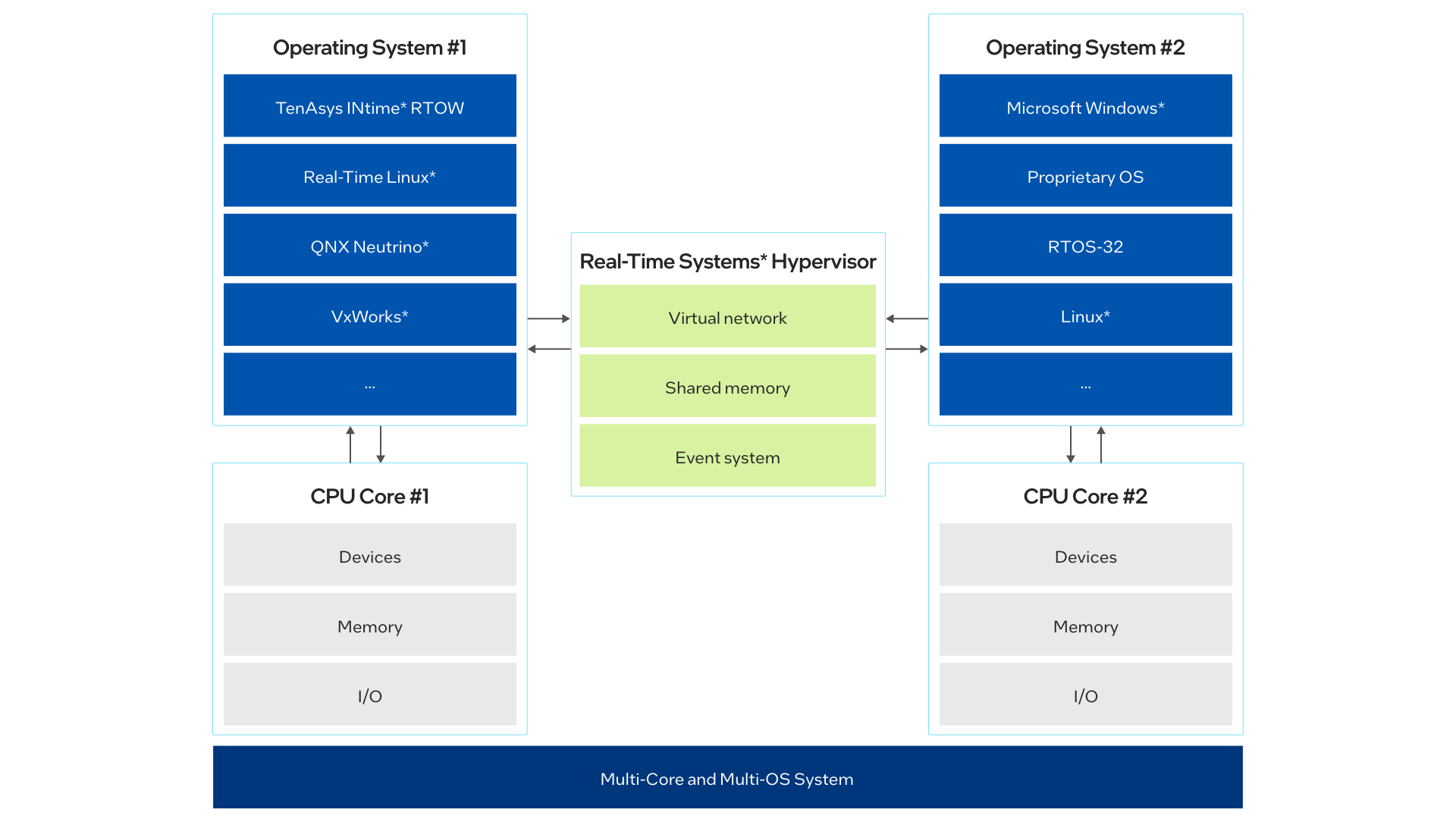Overview
Bare-metal hypervisor from Real-Time Systems* allows OSs to run in real time or in a virtualized environment. Supports multiple Intel software solutions including Intel® Edge Controls for Industrial.
This solution is provided by Real-Time Systems and can be requested at https://www.real-time-systems.com/contact/contact.html.
Target System Requirements
- The Real-Time Systems Hypervisor runs on any modern x86 based PC with any chipset. Certain features (e.g., IOMMU) may require hardware support.
- Minimum hardware requirements: 1 MB Memory
- Bootloader memory space depends on the General Purpose Operating System (GPOS).
How It Works
Real-Time Systems Hypervisor is a software agent that partitions the hardware resources of a standard x86, multicore-processor execution platform in such a way that multiple operating systems can be run concurrently and completely independent of one another. Under the Real-Time Systems Hypervisor, multiple operating systems run at full speed, without an intervening software layer to detract from native real-time processing.
Using this product, you can assemble a system that either runs multiple instances of a real-time operating system or a heterogeneous mixture of operating systems that can also include a GPOS, all on a single multicore execution platform.
Because it takes advantage of the sophisticated hardware resources of modern multicore microprocessor chips, the Real-Time Systems Hypervisor’s virtualization is uncompromised. It provides complete hardware-assisted separation between operating system environments so that no operating system or its applications can interfere with another operating system.
In the Real-Time Systems Hypervisor environment, standard off-the-shelf operating systems run at full speed and full efficiency. The only known limitations are those imposed by the physical characteristics of the execution platform.
By taking advantage of the Real-Time Systems Hypervisor’s comprehensive configuration capabilities, you can assign computer resources and operating systems to the various CPU cores.
Under the Hypervisor, operating systems are so well isolated from one another that an OS can even be booted or rebooted while other operating systems execute in parallel.
While it is anticipated that you will use the Real-Time Systems Hypervisor to run a conventional operating system (such as Linux* or Microsoft Windows*) next to a real-time operating system such as VxWorks*, Windows Embedded Compact*, Real-Time Linux*, RTOS-32*, T-Kernel, InTime* or QNX*; there is no practical limitation to the types of operating systems that can run in the Hypervisor’s environment. In addition, the number of operating systems that can be run simultaneously is limited only by the extent of the hardware resources.

Get Started
This solution is provided by Real-Time Systems and can be requested at https://www.real-time-systems.com/contact/contact.html.
After sending the request, you will receive a download link that will include documentation, software, and binaries. A detailed user manual describes how to install the hypervisor on Microsoft Windows* / Linux* based systems, as well as an additional manual that describes how to use and configure the Hypervisor.
Run the Solution
- How to install the Real-Time Systems Hypervisor on Windows video
- How to assign a PCI component to a Real Time Operating System (RTOS) video
Summary and Next Steps
After a successful installation of the Real-Time Systems Hypervisor, your “preconfigured” setup (depending on your request, for example, Windows with QNX) will start after a reboot. Many different setups are possible, such as assigning a PCI Device to your RTOS or using a specific USB Device in your GPOS. It all depends on your configuration.
If you want to start developing your RTOS application, you can use any standard debug tool and interface. One of the unique capabilities of the Real-Time Systems Hypervisor is the option to debug your real-time target from another core executing Windows in parallel via the virtual network. No specialized tool is required.
Learn More
To continue learning, see the following guides and software resources:
Release Notes
Real-Time Systems Hypervisor Release Notes.
Support Forum
Contact your FAE regarding technical issues through the evaluation and enabling phases. Send an email to support@real-time-systems.com for any other support topics.
"